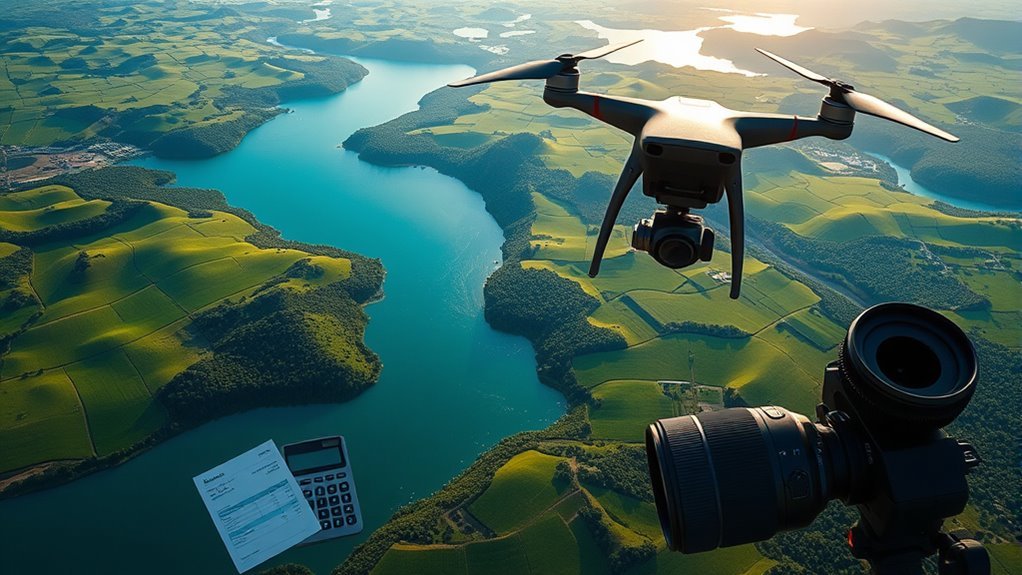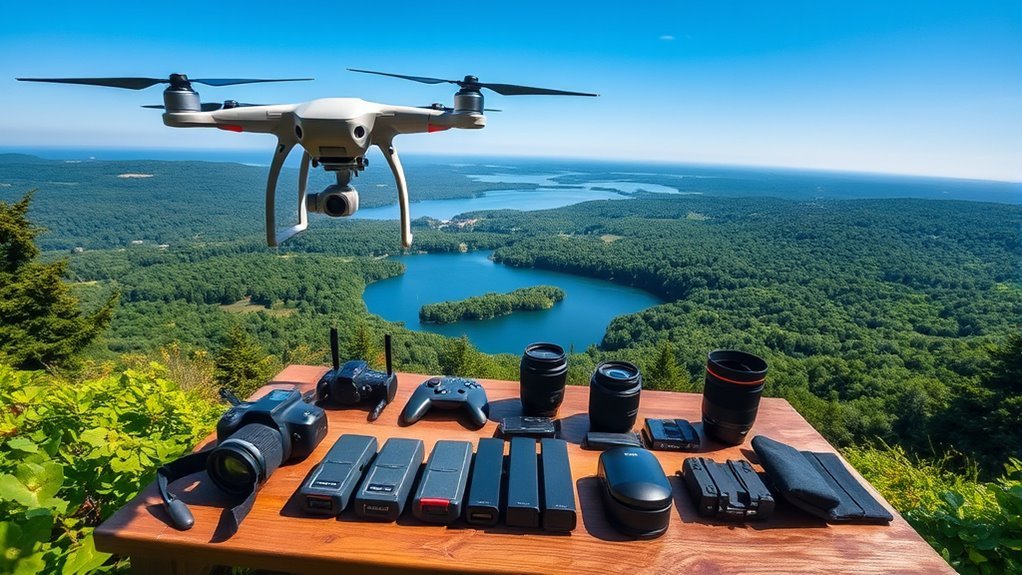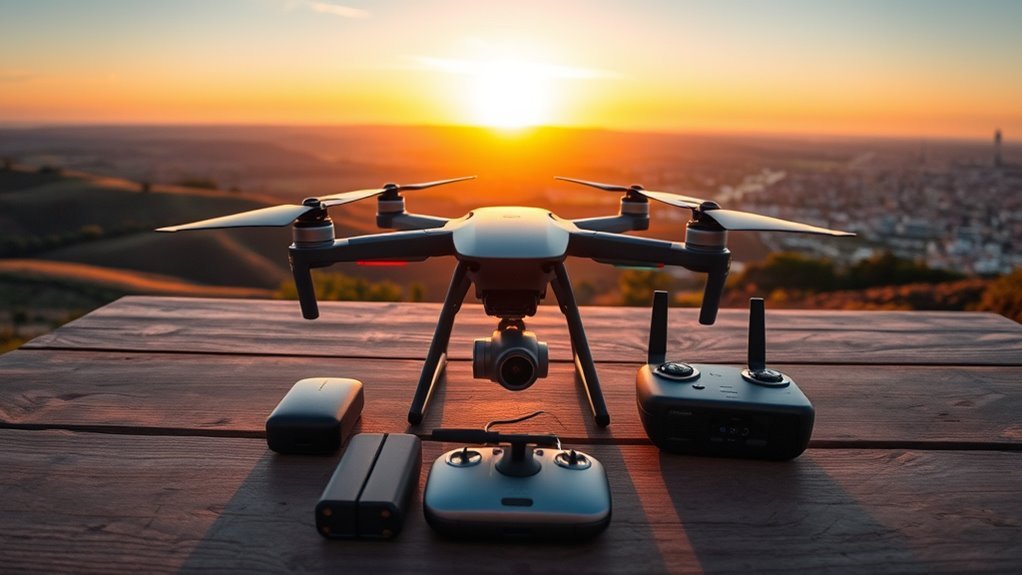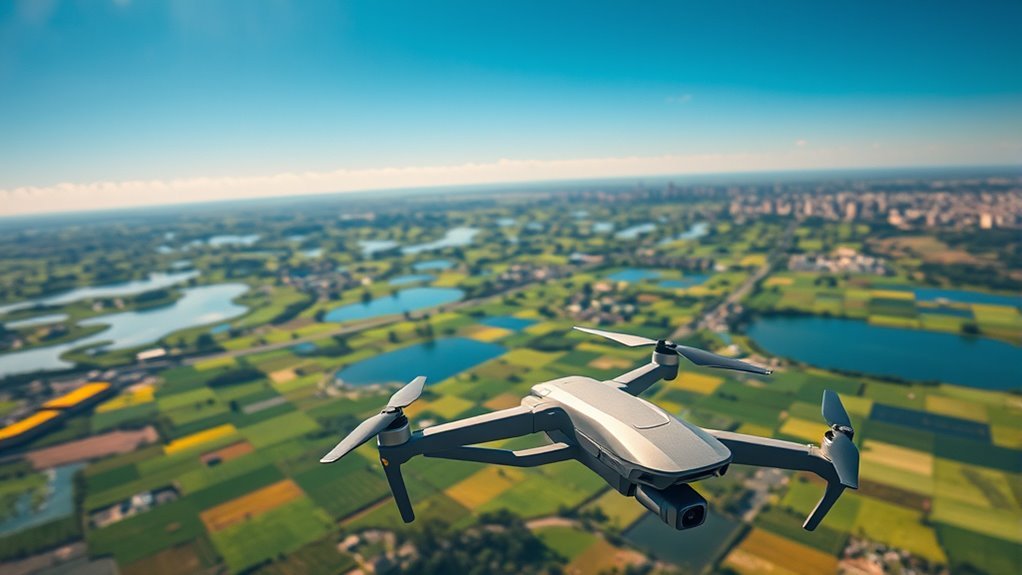Understanding drone photography costs involves several factors including initial investment in high-quality drones, essential accessories, and ongoing fees for professional services. You’ll also need to account for licensing and insurance, which vary by region. While DIY approaches can cut costs, hiring skilled operators can yield superior results. Budgeting for both equipment and potential upgrades is vital. To gain deeper insights into making informed decisions, exploring each cost component is beneficial.
Overview of Drone Photography Costs

When you’re considering the costs associated with drone photography, it’s essential to understand that various factors come into play, from equipment and licensing to operator expertise and project scope. The drone market growth has led to a surge in drone photography trends, impacting pricing structures. You’ll find that high-quality drones can range appreciably in price, while licensing fees for commercial use can add additional costs. Furthermore, hiring skilled operators who know the latest techniques can elevate your project, but it may also increase expenses. Understanding these elements allows you to budget effectively, ensuring your creative vision can take flight without financial constraints, enabling you to explore new perspectives in your projects with confidence and freedom. Additionally, considering the flight endurance and performance of different drones can significantly affect your overall investment in drone photography. For instance, the payload capacity of drones can influence the types of projects you can undertake, as larger capacities may allow for more advanced equipment and better image quality.
Initial Investment: Buying a Drone

When you’re considering buying a drone, it’s vital to understand the different types available, each tailored for specific photography needs. You’ll also need to factor in essential accessories that enhance your shooting experience and improve your results. Finally, budgeting for potential upgrades can guarantee your investment grows with your skills and creative ambitions. Additionally, understanding flight time and battery performance will help you choose a drone that fits your shooting requirements effectively. Evaluating battery efficiency is essential, as it directly impacts how long you can capture those perfect shots without interruption.
Drone Types Overview
As you consider entering the world of drone photography, understanding the various types of drones available is vital for making an informed investment. Drones come in various categories, from entry-level models designed for beginners to advanced UAVs tailored for professional photographers. Each type offers different drone capabilities, such as camera quality, flight time, and stability. For instance, a GPS-enabled drone guarantees precise control and safety, while racing drones focus on agility. It’s important to note that drone regulations vary by region, impacting which drone you can legally fly. By aligning your choice with your photography goals and adhering to these regulations, you’ll find the perfect drone that not only meets your creative needs but also grants you the freedom to explore the skies.
Essential Accessories Needed
Selecting the right drone is just the beginning of your journey into aerial photography; equipping yourself with the right accessories is equally important for maximizing your experience. Invest in high-quality drone filters to enhance your images—polarizers reduce glare and improve color saturation, while ND filters help manage exposure in bright conditions. You’ll also want to stock up on ample memory cards. High-capacity, fast-write-speed cards are essential to capture high-resolution images and videos without interruption. They guarantee you won’t miss that perfect shot while you’re out exploring. Don’t forget to take into account a carrying case for protection and portability. These accessories not only elevate your photography but also empower your creative freedom in the skies.
Budgeting for Upgrades
While you might be enthusiastic to take to the skies with your new drone, it’s essential to establish a realistic budget for your initial investment. A well-planned budget allocation not only guarantees you can purchase your drone but also prepares you for potential upgrades down the line. When considering your spending, keep these key areas in mind:
- Drone Quality: Invest in a drone that meets your photography needs without compromising on features.
- Accessories: Factor in costs for additional batteries, propellers, and storage devices.
- Upgrading Equipment: Set aside funds for future enhancements, like better cameras or software, to elevate your aerial photography.
Essential Accessories and Equipment

When you’re investing in drone photography, the quality of your camera can greatly impact your results. It’s also vital to take into account essential backup gear, like extra batteries and memory cards, to guarantee you’re always ready for that perfect shot. By equipping yourself with these accessories, you can enhance your capabilities and protect your investment in the long run. Additionally, incorporating tools like the Potensic 4K gimbal can significantly improve video stability during your aerial shoots. This technology utilizes 3-axis stabilization to counter movements and ensure smoother footage in dynamic environments.
Camera Quality Matters
In the domain of drone photography, the quality of your camera can make or break your shots. A high-resolution camera paired with superior lens quality guarantees your aerial images are stunningly clear and detailed. Here are a few key factors to take into account:
- Camera Resolution: Aim for a camera with at least 12MP to capture intricate details in your shots.
- Lens Quality: A high-quality lens minimizes distortion, enhancing image sharpness.
- Sensor Size: Larger sensors typically perform better in low light and provide a wider dynamic range.
Essential Backup Gear
To guarantee your drone photography sessions run smoothly, having the right backup gear is vital. You’ll want to invest in multiple backup batteries to make certain your drone stays airborne for longer periods. Running out of power can cut your creative flow short, so being prepared is key. Additionally, consider reliable storage solutions, like high-capacity SD cards or external hard drives, to safeguard your footage. After capturing stunning shots, it’s essential to have a plan for storing and organizing your files, preventing data loss during transfer. With these essentials, you’ll not only enhance your efficiency but also free your mind to focus on capturing breathtaking images, knowing you’re equipped for any situation that may arise.
Professional Photography Fees
Understanding professional photography fees for drone services can be complex, with costs ranging from a few hundred to several thousand dollars depending on various factors. Your budget will largely depend on the photographer’s professional experience, as well as the specific pricing packages they offer. Here are key elements that influence your fees:
Professional drone photography fees vary widely, influenced by experience, project scope, equipment, and post-processing needs.
- Project Scope: The complexity and duration of the shoot.
- Equipment Used: High-quality drones and cameras can increase costs. For instance, drones like the DJI Mavic 3 Pro offer advanced features that enhance image quality and safety, justifying a higher price point.
- Post-Processing: Editing and delivering final images may add to the expense. Additionally, the choice of drone capabilities can significantly impact the overall cost due to the varying levels of technology and performance offered by different models.
Additional Costs: Licensing and Insurance
While you may focus on the primary fees associated with hiring a drone photographer, additional costs such as licensing and insurance can greatly impact your overall budget. Understanding the licensing requirements is important, as different regions may necessitate specific permits or certifications to operate drones legally. Without these, you risk fines or project delays.
Additionally, exploring various insurance options is necessary to protect against potential liabilities. Coverage may include damage to property or accidents involving third parties. Not all photographers include insurance in their fees, so clarifying this upfront is significant. By factoring in these additional costs, you can guarantee a smoother, more legally compliant aerial photography experience that truly captures your vision.
Cost Comparison: DIY vs. Hiring a Professional
When considering drone photography, weighing the costs of a DIY approach against hiring a professional can considerably affect your project’s outcome. Each option has its merits, so let’s break it down.
DIY advantages:
- You save money upfront by avoiding professional fees.
- You gain complete creative control over the shooting process.
- You can develop your skills and learn the craft firsthand. Additionally, understanding common exclusions in drone insurance policies can help you avoid unexpected costs during your DIY projects.
On the other hand, professional expertise guarantees high-quality results, as seasoned pilots know how to capture stunning images and navigate challenging environments. They also come equipped with advanced technology and editing skills that can elevate your project. Additionally, understanding advanced technology integration in drone operations can enhance your DIY efforts significantly. Ultimately, deciding between DIY and hiring a pro hinges on your budget, skills, and desired outcome. Choose wisely to achieve your vision!
Factors Influencing Overall Costs
Several key factors influence the overall costs of drone photography, impacting both DIY enthusiasts and those opting for professional services. First, understanding drone regulations in your area is vital; compliance can add to costs, especially if permits or licenses are required. Additionally, the equipment you choose plays a significant role—high-quality cameras and drones can be pricey but yield better results. The advanced camera capabilities of the XG Neith Drone, for instance, can significantly enhance the quality of your photos and videos. Market demand also affects pricing; in areas where drone services are in high demand, you might find higher rates. Finally, post-processing skills and software can add to your expenses, whether you’re editing your own shots or hiring a professional. Balancing these factors helps guarantee you get the best value for your drone photography investment. Moreover, the battery life of your drone directly impacts how long you can shoot before needing to recharge, which can influence the overall cost of your projects.
Frequently Asked Questions
Can I Use a Drone for Real Estate Photography?
Absolutely, you can use a drone for real estate photography. Drones offer unique advantages, capturing stunning aerial perspectives that highlight property features, enhancing visual appeal and marketing effectiveness, ultimately benefiting your real estate endeavors greatly.
What Are the Legal Restrictions for Drone Photography?
Flying a drone feels like soaring through the skies, but you’ve gotta navigate drone regulations and airspace restrictions. Always check local laws to verify your aerial adventures don’t end in a legal tailspin!
How Long Does a Drone Battery Last During a Shoot?
During a shoot, a drone’s battery lifespan typically ranges from 20 to 30 minutes, depending on the model and conditions. It’s essential to plan your shoot duration accordingly to maximize aerial opportunities and capture stunning visuals.
Are There Ongoing Maintenance Costs for Drones?
It’s funny how often you’ll find drone repairs popping up unexpectedly, isn’t it? Plus, don’t forget about insurance costs. Regular maintenance is key to keeping your drone flying smoothly and avoiding costly surprises down the line.
What Software Is Needed for Editing Drone Photos?
For editing drone photos, you’ll need robust editing software like Adobe Lightroom or Photoshop. These tools excel at photo enhancement, offering advanced features for color correction, cropping, and applying creative filters to elevate your aerial imagery.

